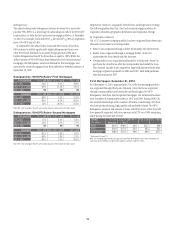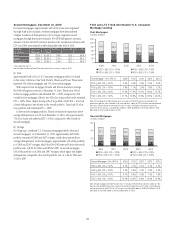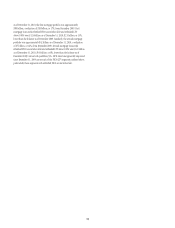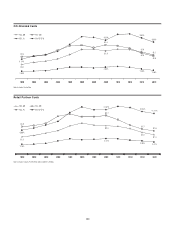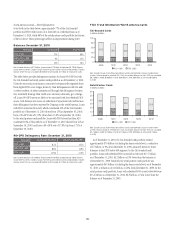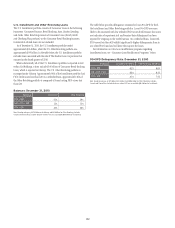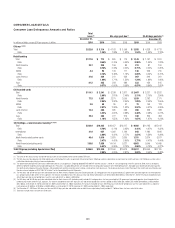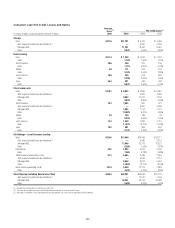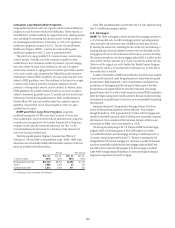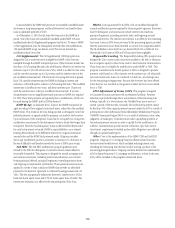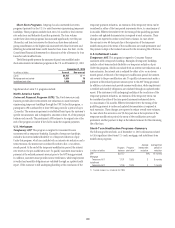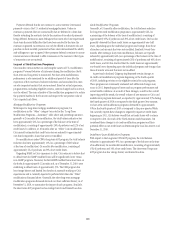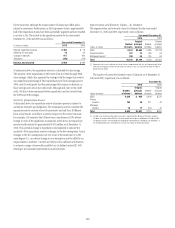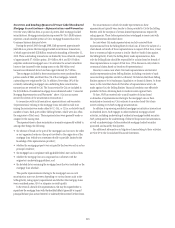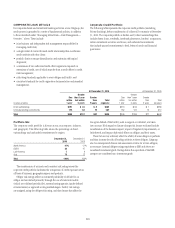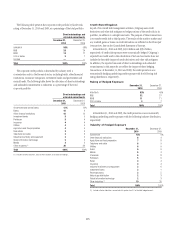Citibank 2010 Annual Report Download - page 107
Download and view the complete annual report
Please find page 107 of the 2010 Citibank annual report below. You can navigate through the pages in the report by either clicking on the pages listed below, or by using the keyword search tool below to find specific information within the annual report.
105
Consumer Loan Modification Programs
Citigroup has instituted a variety of long-term and short-term modification
programs to assist borrowers with financial difficulties. These programs, as
described below, include modifying the original loan terms, reducing interest
rates, extending the remaining loan duration and/or waiving a portion of
the remaining principal balance. At December 31, 2010, Citi’s significant
modification programs consisted of the U.S. Treasury’s Home Affordable
Modification Program (HAMP), as well as short-term and long-term
modification programs in the U.S., each as summarized below.
The policy for re-aging modified U.S. consumer loans to current status
varies by product. Generally, one of the conditions to qualify for these
modifications is that a minimum number of payments (typically ranging
from one to three) be made. Upon modification, the loan is re-aged to
current status. However, re-aging practices for certain open-ended consumer
loans, such as credit cards, are governed by Federal Financial Institutions
Examination Council (FFIEC) guidelines. For open-ended consumer loans
subject to FFIEC guidelines, one of the conditions for the loan to be re-aged
to current status is that at least three consecutive minimum monthly
payments, or the equivalent amount, must be received. In addition, under
FFIEC guidelines, the number of times that such a loan can be re-aged is
subject to limitations (generally once in 12 months and twice in five years).
Furthermore, Federal Housing Administration (FHA) and Department of
Veterans Affairs (VA) loans are modified under those respective agencies’
guidelines, and payments are not always required in order to re-age a
modified loan to current.
HAMP and Other Long-Term Programs. Long-term
modification programs or TDRs occur when the terms of a loan have
been modified due to the borrower’s financial difficulties and a long-term
concession has been granted to the borrower. Substantially all long-term
programs in place provide interest rate reductions. See Note 1 to the
Consolidated Financial Statements for a discussion of the allowance for
loan losses for such modified loans.
The following table presents Citigroup’s Consumer loan TDRs as of
December 31, 2010 and 2009. As discussed below under “HAMP,” HAMP loans
whose terms are contractually modified after successful completion of the trial
period are included in the balances below:
Accrual Non-accrual
In millions of dollars
Dec. 31,
2010
Dec. 31,
2009
Dec. 31,
2010
Dec. 31,
2009
Mortgage and real estate $15,140 $8,654 $2,290 $1,413
Cards (1) 5,869 2,303 38 150
Installment and other 3,015 3,128 271 250
(1) 2010 balances reflect the adoption of SFAS 166/167.
These TDRs are predominately concentrated in the U.S. Citi’s significant long-
term U.S. modification programs include:
U.S. Mortgages
HAMP. The HAMP is designed to reduce monthly first mortgage payments to
a 31% housing debt ratio (monthly mortgage payment, including property
taxes, insurance and homeowner dues, divided by monthly gross income)
by lowering the interest rate, extending the term of the loan and deferring or
forgiving principal of certain eligible borrowers who have defaulted on their
mortgages or who are at risk of imminent default due to economic hardship.
The interest rate reduction for first mortgages under HAMP is in effect for five
years and the rate then increases up to 1% per year until the interest rate cap
(the lower of the original rate or the Freddie Mac Weekly Primary Mortgage
Market Survey rate for a 30-year fixed rate conforming loan as of the date of
the modification) is reached.
In order to be entitled to a HAMP loan modification, borrowers must complete
a three-month trial period, make the agreed payments and provide the required
documentation. Beginning March 1, 2010, documentation was required to be
provided prior to the beginning of the trial period, whereas prior to that date,
documentation was required before the end of the trial period. This change
generally means that Citi is able to verify income for potential HAMP participants
before they begin making lower monthly payments. Because customers entering
the trial period are qualified prior to trial entry, more are successfully completing
the trial period.
During the trial period, Citi requires that the original terms of the loans
remain in effect pending completion of the modification. From inception
through December 31, 2010, approximately $9.5 billion of first mortgages were
enrolled in the HAMP trial period, while $3.8 billion have successfully completed
the trial period. Upon completion of the trial period, the terms of the loan are
contractually modified, and it is accounted for as a TDR.
Citi also began participating in the U.S. Treasury’s HAMP second mortgage
program (2MP) in the fourth quarter of 2010. 2MP requires Citi to either:
(1) modify the borrower’s second mortgage according to a defined protocol; or
(2) accept a lump sum payment from the U.S. Treasury in exchange for full
extinguishment of the second mortgage. For a borrower to qualify, the borrower
must have successfully modified his/her first mortgage under the HAMP and
met other criteria. Under the 2MP program, if the first mortgage is modified
under HAMP through principal forgiveness, the same percentage of principal
forgiveness is required on the second mortgage.



